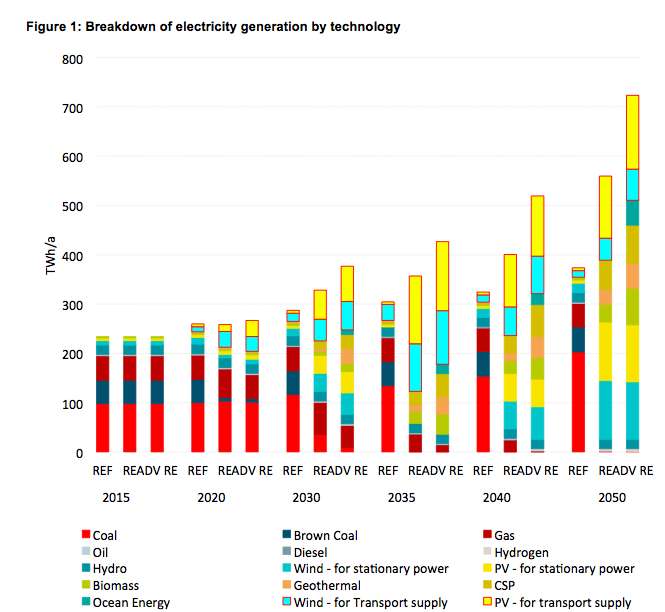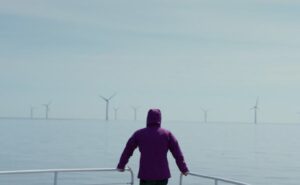A new report from the Institute for Sustainable Futures in Sydney says a rapid transition to a 100 per cent renewable energy system can save Australia money – with avoided fuel costs to quickly offset the extra capital expenditure of building wind, solar and other renewable energy installations.
“The transition to a 100 per cent renewable energy system by 2050 is both technically possible and economically viable in the long term,” the report says. And by 100 per cent renewable, it means all energy use, including transport and heating.
The report canvasses two renewable energy scenarios, one based on a high level of renewable energy in the electricity grid, but with transport largely reliant on fossil fuels. The second is the Advanced Renewables scenario, which canvasses a totally renewable electricity system by 2030 and a fully renewable energy system by 2050.
This graph above shows the proposed fuel mix on the various scenarios, and how they compare to the “reference” rate of current policies, which continues to rely heavily on black and brown coal, and gas.
Interestingly, the ‘advanced renewables” scenario includes a significant share of ocean energy and geothermal energy, which have yet to make their mark in Australia, along with solar thermal and storage and biomass, which will add to the “flexible” generation capacity that will fill the gaps between wind and solar.
Another important component is hydrogen, which is introduced as a substitute for natural gas, and makes up a significant share of transport fuels after 2030. Hydrogen is assumed to be produced via electrolysis, via wind and solar PV – hence the large amounts of wind and PV “for transport” only in the advanced renewable scenario.
Indeed, the report, commissioned by activist groups Get Up and Solar Citizens, says solar and wind will become the “main pillars” of electricity supply in Australia, in a reshaped market that is not built around the conventional “base load” concept, which the authors say is an economic construct rather than a technical one.
The release of the report comes at the same time as the effective launch of an election campaign that features relatively modest policies from the mainstream parties, and highlights the yawning and growing gap between what is possible (and cost effective) and what the major parties propose.
Labor is aiming for 50 per cent renewable energy in electricity by 2030, while the Coalition has no policy beyond its 33,00GWh (effectively 23 per cent) renewables target for 2020. Ironically, it was prime minister Malcolm Turnbull who helped launch an earlier 100 per cent renewables scenario by Beyond Zero Emissions, back in 2010.
Get UP’s Miriam Lyons said investing in the shift to renewables would mean lower wholesale electricity prices as early as 2025.
“Australia’s shambolic electricity system is not clean, cheap, modern, competitive or fair,” Lyons said.
“The only people it suits are a handful of big coal-burning power companies along with network companies who spent $75 billion building far more energy infrastructure than we need.
“That’s a racket, and the Homegrown Power Plan shows how we can fix it. It also shows how clean energy auctions can help deliver low prices on the way to 100% renewable power.”
A 100 per cent renewable energy system has already been acknowledged as technically feasible by the likes of the Australian Energy Market Operator, despite the constant skepticism from the coal and nuclear lobbies, based around the idea that the system needs “base load”.
The advanced renewables scenario suggests all coal-fired plants should be shut down by 2030, and to be combined by a doubling in energy productivity by the same date (rather than the current government target of 40 per cent increase).
It also envisages renewable energy supplying 97 per cent of total electricity demand – including electrified transport – by 2035, and firm capacity remaining at today’s level of approximately 75 per cent throughout the entire scenario period.
It suggests that the supply of energy is 41 per cent renewable by 2035, 64 per cent by 2040 and 100 per cent by 2050, enabling Australia to become independent from oil imports within one generation.
The industry sector will be 50 per cent renewable by 2035 and 100 per cent by 2050. (Interestingly Alcoa is trialling solar technology that it says could reduce fossil fuel use by 50 per cent in various refining processes.)
All of this leads to higher investment costs of $800 billion out to 2050, compared to $150 billion in the reference scenario, much of it spent switching transport and heating sectors over to electricity, and gearing it towards the use of synthetic fuels.
But because renewable technologies have no ongoing fuel costs, there will be fuel savings in the power sector of $340 billion and in the transport sector of $400 billion. This will more than compensate for the higher investment costs.
“The combined power and transport fuel cost savings would cover around 110 per cent of the capital investment cost,” the report says. “New renewable power generation needed for a 100 per cent renewable energy system can therefore be financed by fuel cost savings before 2050.”
 The report, does, however, envisage some ambitious installation rates – at well above current installation rates.
The report, does, however, envisage some ambitious installation rates – at well above current installation rates.
It says that the average annual installations for solar PV between 2015 and 2030 – to meet its 2030 target of 72GW – are at around 4,500 MW, “only four times” more than the PV market size of 2011, 2012 and 2015 but equivalent to the entire market installed to date.
It says the wind turbine installations will need to “remain” at 2,600 MW a year for the coming 15 years – when in fact it has been far lower than that in recent years.
But it says this is equal to the development in the German wind power market between 1999 and 2014, a country smaller in area than New South Wales. “There are neither space nor wind resource constraints to building the wind and solar capacities projected in the Advanced Renewables case until 2050 or exceeding this market size.”
As the renewable energy capacity is built up in “moderate annual steps” – based on the experiences of other OECD countries of the past 15 years – existing coal power plants will be retired step by step, at a rate of approximately 750MW per year, equal to one or two average coal power plant blocks.









